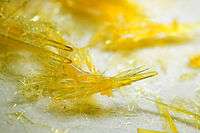Potassium hexacyanochromate(III)
%2C_2015-10-29.jpg) | |
 | |
| Names | |
|---|---|
| IUPAC name
Potassium hexacyanochromate(III) | |
| Identifiers | |
| 13601-11-1 | |
| 3D model (Jmol) | Interactive image |
| ChemSpider | 19988791 |
| ECHA InfoCard | 100.033.694 |
| EC Number | 237-079-8 |
| MeSH | Hexacyanochromate |
| PubChem | 21123765 |
| |
| |
| Properties | |
| C6CrK3N6 | |
| Molar mass | 325.40 g·mol−1 |
| Appearance | Vivid, yellow, opaque crystals |
| Except where otherwise noted, data are given for materials in their standard state (at 25 °C [77 °F], 100 kPa). | |
| Infobox references | |
Potassium hexacyanochromate(III) is a coordination compound with the formula K3[Cr(CN)6]. It consists of three potassium cations and a central hexacyanometallate with [Cr(CN)6]3− anion. It is a yellow, air-stable, paramagnetic solid. It is not stable at higher temperatures, forming chromium(III) hydroxide precipitate.
The salt is prepared by treating chromium trioxide, dissolved in concentrated hydrochloric acid, with ethanol in a redox reaction. Following the solution is evaporated to dryness. The residue is dissolved in a boiling solution of KCN. The evaporation is repeated, but not till dryness. The concentrated solution is left in the cold to sulphur.[1]
The Cr(II) derivative is unusual and has been little studied.[2]
References
- ↑ Cruser, Frederick Van Dyke; Miller, Edmund H. (1906). "The insoluble Chromicyanides". J. Am. Chem. Soc. 28 (9): 1132–51. doi:10.1021/ja01975a003.
- ↑ Deeth, R.J. (2006). "A Theoretical Rationale for the Formation, Structure and Spin State of Pentacyanochromate(II)". European Journal of Inorganic Chemistry. 2006 (13): 2551–2555. doi:10.1002/ejic.200600137.
This article is issued from Wikipedia - version of the 6/5/2016. The text is available under the Creative Commons Attribution/Share Alike but additional terms may apply for the media files.